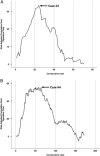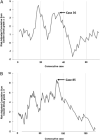Learning curves in laparoscopic distal pancreatectomy: a different experience for each generation
- PMID: 37144678
- PMCID: PMC10389345
- DOI: 10.1097/JS9.0000000000000408
Learning curves in laparoscopic distal pancreatectomy: a different experience for each generation
Abstract
Background: Learning curves of laparoscopic distal pancreatectomy (LDP) are mostly based on 'self-taught' surgeons who acquired sufficient proficiency largely through self-teaching. No learning curves have been investigated for 'trained' surgeons who received training and built on the experience of the 'self-taught' surgeons. This study compared the learning curves and outcome of LDP between 'self-taught' and 'trained' surgeons in terms of feasibility and proficiency using short-term outcomes.
Materials and methods: Data of consecutive patients with benign or malignant disease of the left pancreas who underwent LDP by four 'self-taught' and four 'trained' surgeons between 1997 and 2019 were collected, starting from the first patient operated by a contributing surgeon. Risk-adjusted cumulative sum (RA-CUSUM) analyses were performed to determine phase-1 feasibility (operative time) and phase-2 proficiency (major complications) learning curves. Outcomes were compared based on the inflection points of the learning curves.
Results: The inflection points for the feasibility and proficiency learning curves were 24 and 36 procedures for 'trained' surgeons compared to 64 and 85 procedures for 'self-taught' surgeons, respectively. In 'trained' surgeons, operative time was reduced after completion of the learning curves (230.5-203 min, P= 0.028). In 'self-taught' surgeons, operative time (240-195 min, P ≤0.001), major complications (20.6-7.8%, P= 0.008), and length of hospital stay (9-5 days, P ≤0.001) reduced after completion of the learning curves.
Conclusion: This retrospective international cohort study showed that the feasibility and proficiency learning curves for LDP of 'trained' surgeons were at least halved as compared to 'self-taught' surgeons.
Trial registration: ClinicalTrials.gov NCT05595343.
Copyright © 2023 The Author(s). Published by Wolters Kluwer Health, Inc.
Conflict of interest statement
There are no conflicts of interest.
Sponsorships or competing interests that may be relevant to content are disclosed at the end of this article.
Figures



References
-
- Abu Hilal M, Takhar AS. Laparoscopic left pancreatectomy: current concepts. Pancreatology 2013;13:443–448. - PubMed
-
- de Rooij T, Jilesen AP, Boerma D, et al. A nationwide comparison of laparoscopic and open distal pancreatectomy for benign and malignant disease. J Am Coll Surg 2015;220:263–70.e1. - PubMed
-
- Jusoh AC, Ammori BJ. Laparoscopic versus open distal pancreatectomy: a systematic review of comparative studies. Surg Endosc 2012;26:904–913. - PubMed
-
- Mehrabi A, Hafezi M, Arvin J, et al. A systematic review and meta-analysis of laparoscopic versus open distal pancreatectomy for benign and malignant lesions of the pancreas: it’s time to randomize. Surgery 2015;157:45–55. - PubMed
MeSH terms
Associated data
LinkOut - more resources
Full Text Sources
Medical

